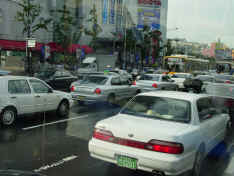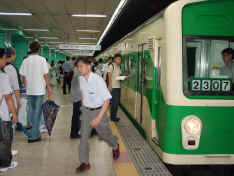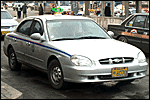|
Transportation in Seoul

There are several choices available for transportation in Seoul: taxis,
buses, and the subway. Almost any point in Seoul can be reached using one
of these modes of transportation. The basic idea behind building Seoul's
transportation network was to connect the bus routes to the subway system.
The average Korean uses public transportation daily. The traffic situation
is very serious in Seoul, especially during rush hour, which is from 7 - 9 in
the morning and from 4 - 7 in the evening. It's a good idea to avoid being
out during rush hour, if possible, but buses and the subway are still very good
transportation to travel around Seoul because they are very inexpensive,
convenient and easy to use.

Subway
The subway, with eight lines and one national railway line, covers the entire
area of Seoul including surrounding areas. Most stations are underground,
but you will find some are above ground. Subway rains arrive on average
about every five minutes, although during rush hour you can expect one to arrive
about every two minutes. Service is available from 5:30 a.m. to 12 a.m. on
most lines.
Subway signs are generally in Korean and English, but keeping a small subway
map makes it much easier to get around Seoul. There are two different
fares for the subway, depending on the zone you travel. Zone one is 500
won (US $.40 - approx), zone two is 600 won (US $.50 - approx). There is a
fifty percent discount for children, soldiers and the elderly.
Subway passes may be purchased with a ten percent discount in increments of
20,000 won, 10,000 won and 5,000 won and can be purchased at ticket counters and
at vending machines located in the station. The pass has a magnetic strip,
so try to avoid demagnetizing it, but if there is a problem take it to the
ticket counter and they can correct it for you.
Most subway stations and trains are very clean and modern, except for the
national railway since it is an older line. Bathrooms and vending machines
are available at most stations, while some have eating and shopping areas as
well. The subway stations are strictly no smoking areas, except for
immediately outside the station. It's a good idea to avoid the rush hour.
Back to Top
Buses
There are three different kinds of bus: regular, express and village (shuttle
bus). Buses take thirty percent of the daily traffic and they start
service at 5:30 a.m. and end about 12 a.m. Buses arrive varying from five
to ten minutes apart, depending on traffic. There are approximately 400
bus routes in Seoul, which can be very confusing to a foreigner, unlike the
subway which is relatively easy to use. Most express buses have
air-conditioning, while only some of the regular or village buses do.
Regular (Ilban) Bus
The fare is 500 won for adults, 340 won for students and 200 won for
children. Cheaper than the express bus, the regular bus has more stops,
which means it takes longer to get to your destination. You can pay with
tokens, cash, and bus pass.
Express Bus
The advantage of using the express bus is that there are usually seats
available, less stops which means faster service and more comfortable than the
regular bus. Air conditioning is always available in these buses.
The fare is 1,100 won ($1 US) and can be paid with tokens, cash and bus pass.
Village (Shuttle) Bus
These have very short lines and only service short distances in the small
districts. They mainly connect the subway station to a few places in those
districts. The price depends on the village, but averages 300 - 400 won
($.25 -.30 US).
Bus Card
Bus cards are available in increments of 20,000 won, 10,000 won and 5,000 won
and can be purchased at news stands located near the bus stops.
Back to Top

Taxis
Taxis are available anywhere and are generally clean. The prices are
non-negotiable as the taxis have meters that calculate the fare according to
distance and time. You can flag down a taxi almost anywhere in the
city and as long as they don't have a passenger, they'll stop. There
are two different kinds of taxis: general and deluxe.
Regular (Ilban) Taxi
These taxis are generally white or silver and the top will have a
"taxi" sign. The fare is calculated according to distance and
time. Once you get in the taxi, the fare automatically starts at 1,300 won
($1.20 US - approx) and goes up after two kilometers, depending on traffic, then
increases one hundred won (approx $.10 US) every 210 meters or 51 seconds.
The ilban taxi is relatively inexpensive in comparison to taxis in other
metropolitan cities around the world. These taxis are generally clean and
have good service, but most drivers can't speak English, so have your
destination written in Korean, if possible. Most ilban taxis are Hyundai
Sonatas and Daewoo Leganzas.
Deluxe Taxi
About two times more expensive than the ilban taxi, the deluxe taxi will take
you to any major location in the city. They are trained to serve
foreigners and most can speak basic English, so the service is generally
excellent. Car phones are available for use. Still, compared to
other metropolitan cities around the world, they are a good value. The
price is not negotiable and tipping is not necessary.
Tips for Riding in Taxis
If there is a small amount of change due back, most Koreans don't get it but
let the driver take it as his tip. For example if the fare is 1900 won,
they will just give 2000 won and leave the 100 won.
During rush hour it is common for Koreans to share their taxi with others,
but it is illegal. In spite of this, it still happens very frequently.
Back to Top
Seoul
City Tour Bus
The Seoul City Tour Bus is another way to travel around
Seoul. It is a new service that has just started in winter 2000. It
goes to all the famous tourist spots in Seoul, but doesn't go to every location
in Seoul. The main locations are downtown Seoul, Namdaemun Market, Itaewon
and goes around the various palaces. The buses arrive at the stops every
25 minutes, official time, but there may be delays due to traffic. For a
flat fee, a tourist can get off and on the bus at any stop. The flat fees
are W5,000 during the day, W5,000 during the night, W8,000 for an entire
day. Tickets may be purchased at various bus stops or tourist locations
around Seoul. Or, tourists may pay the driver cash when they get on the
bus and get their tickets then. It is an excellent way to experience
Seoul, without spending a lot of money, for those without a lot of time to
spare.
Back to Top
|

